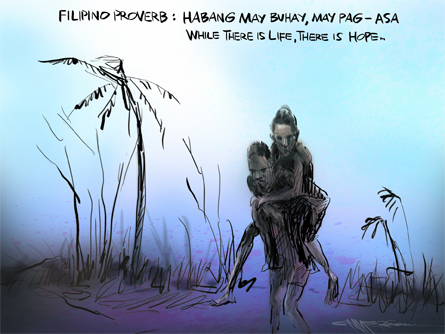Not having to go to school for two, sometimes three, days was fun for years. That was until September 2006, when Typhoon Xangsane struck Manila. We had no power for three days, but some areas - even those in more affluent neighbourhoods than ours - had no electricity for up to a week. We couldn’t travel anywhere because billboards had fallen on the motorways. Xangsane killed around 200 people.
I was 12 years old then, and yeah, in the back of my head, I knew that people died in typhoons. However, this was the first time that I saw something sinister in them.
Xangsane’s destructive winds wreaked havoc on Roxas Boulevard’s Manila Bay waterfront.
Image credit: acermate433s, Flickr
Little did I know that Xangsane wasn’t going to be the last, or the worst, of the batterings the Philippines would receive over the next seven years.
Typhoon Haiyan made its first landfall over the Visayas region of the Philippines in the early hours of last Saturday, 9 November. During its formation and approach, meteorologists proclaimed that it will be the strongest storm to make landfall in recorded history.
Its aftermath did more than enough to live up to the hype.
Tacloban City after Typhoon Haiyan
Image credit: Toti Ravales, AP
There are fatalities, people still unaccounted for, looting and trouble with relief aid reaching the survivors. We’ve heard it all over the news, so I won’t repeat it here. But I do want to talk about Haiyan in a wider context.
I’m the furthest thing from a climate activist. Race relations, women’s rights, economic inequality? Yeah, I can talk to you about that. But climate change? Not so much. I know enough about it to recognise that it’s real, and that it’s happening.
The New Zealand government may be laughing, but the delegations at the UN Climate Talks in Poland aren’t, and neither are the millions of Filipinos in the Philippines and all over the world wondering when nature will give our country a break.
It doesn’t look like it's going to be anytime soon.

No one doubts the resilience of the Filipino people. We’re world famous for it. Filipino children are raised to be resilient. Good men in storms, if you will, to paraphrase a Grey’s Anatomy character.
It doesn’t look like it's going to be anytime soon.
Editorial cartoon, 12 November 2013
Image credit: Rod Emmerson, NZ Herald
No one doubts the resilience of the Filipino people. We’re world famous for it. Filipino children are raised to be resilient. Good men in storms, if you will, to paraphrase a Grey’s Anatomy character.
We have bounced back from disasters. We have cleaned up, rebuilt and carried on with our lives. But we know that the day might come when Filipinos may not recover as well as we did in the past. Perhaps, with Typhoon Haiyan, that day has already come.
The international jury still seems to be out on climate change causing Typhoon Haiyan, but let me throw out some facts out. At the current body count, Haiyan is the third deadliest typhoon in recorded Philippine history. Out of the top 10 deadliest typhoons in the Philippines, six of them occurred in the 21st century, specifically in the last ten years. The cost of the damage Typhoon Haiyan has caused has not yet been calculated, but it’s sure to make the top 10, if not take the number one spot. Looking at that list of the costliest Philippine typhoons, six out of ten occurred in the last five years.
Make what you will of these facts.
It’s clear that Haiyan will not be the last deadly super typhoon to make landfall in the Philippines. Are we going to expect the Filipino people to pick themselves right back up again and again? Or are we going to fulfil our responsibility as global citizens to stand in solidarity with them in the fight to mitigate climate change?
If anything, Typhoon Haiyan proved that climate change is not just an environmental issue, but a humanitarian one as well.
The international jury still seems to be out on climate change causing Typhoon Haiyan, but let me throw out some facts out. At the current body count, Haiyan is the third deadliest typhoon in recorded Philippine history. Out of the top 10 deadliest typhoons in the Philippines, six of them occurred in the 21st century, specifically in the last ten years. The cost of the damage Typhoon Haiyan has caused has not yet been calculated, but it’s sure to make the top 10, if not take the number one spot. Looking at that list of the costliest Philippine typhoons, six out of ten occurred in the last five years.
Make what you will of these facts.
It’s clear that Haiyan will not be the last deadly super typhoon to make landfall in the Philippines. Are we going to expect the Filipino people to pick themselves right back up again and again? Or are we going to fulfil our responsibility as global citizens to stand in solidarity with them in the fight to mitigate climate change?
If anything, Typhoon Haiyan proved that climate change is not just an environmental issue, but a humanitarian one as well.
No comments:
Post a Comment